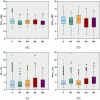Synthetic mucus for an ex vivo phonation setup: Creation, application, and effect on excised porcine larynges
- PMID: 36586828
- PMCID: PMC9729017
- DOI: 10.1121/10.0015364
Synthetic mucus for an ex vivo phonation setup: Creation, application, and effect on excised porcine larynges
Abstract
Laryngeal mucus hydrates and lubricates the deformable tissue of the vocal folds and acts as a boundary layer with the airflow from the lungs. However, the effects of the mucus' viscoelasticity on phonation remain widely unknown and mucus has not yet been established in experimental procedures of voice research. In this study, four synthetic mucus samples were created on the basis of xanthan with focus on physiological frequency-dependent viscoelastic properties, which cover viscosities and elasticities over 2 orders of magnitude. An established ex vivo experimental setup was expanded by a reproducible and controllable application method of synthetic mucus. The application method and the suitability of the synthetic mucus samples were successfully verified by fluorescence evidence on the vocal folds even after oscillation experiments. Subsequently, the impact of mucus viscoelasticity on the oscillatory dynamics of the vocal folds, the subglottal pressure, and acoustic signal was investigated with 24 porcine larynges (2304 datasets). Despite the large differences of viscoelasticity, the phonatory characteristics remained stable with only minor statistically significant differences. Overall, this study increased the level of realism in the experimental setup for replication of the phonatory process enabling further research on pathological mucus and exploration of therapeutic options.
Figures






